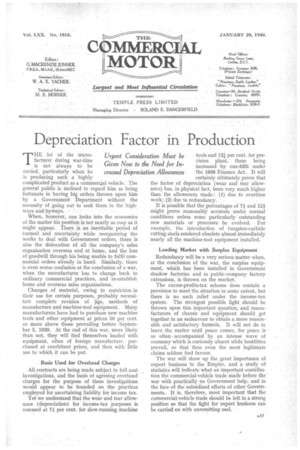Depreciation Factor in Production
Page 19

If you've noticed an error in this article please click here to report it so we can fix it.
THE lot of the manufacturer during war-time is not always to be envied, particularly when he is producing such a highly complicated product as a commercial vehicle. The general public is inclined to regard him as being fortunate in having big orders thrown upon him by a Government Department without the necessity of going out to seek them in the high ways and :byways.
When, however, one looks into the economics of the matter his position is not nearly so rosy as it might appear. There is an inevitable period of turmoil and uncertainty while reorganizing the works to deal with Government orders, there is also the dislocation of all the company's sales organization overseas and at home, and the loss of goodwill through his being unable to fulfil commercial orders already in hand, Similarly, there is even worse confusion at the conclusion of a war, when the manufacturer has to change back to ordinary commercial practices, and re-establish home and overseas sales organizations.
Changes of material, owing to restriction in their use for certain purposes, probably necessitate complete revision of jigs, methods of manufacture and machine-tool equipment. Many manufacturers have had to purchase new machine tools and other equipment at prices 50 per cent. or more above those prevailing before September 3, 1939. At the end of this war, more likely than not, they will find themselves loaded with equipment, often of foreign manufacture, purchased at exorbitant prices, and then with little use to which it can be put.
< Basis Used for Overhead Charges All contracts are being made subject to full cost investigations, and the basis of agreeing overhead charges for the purpose of these investigations would appear to be founded on the practices employed for ascertaining liability for income tax.
Yet we understand that the wear and tear allowance (depredation) for income-tax purposes is. assessed at 74 per cent, for slow-running machine tools and 121 per cent. for precision plant, these being increased by one-fifth under the 1938 Finance Act. It will certainly ultimately prove that the factor of depreciation (wear and tear allowance) has, in physical fact, been very much higher than the allowances made : (1) due to overtime work; (2) due to redundancy.
It is possible that the percentages of 74 and 124 might prove reasonably accurate under normal conditions unless some particularly outstanding new materials or processes be evolved. For example, the introduction of tungsten-carbide cutting steels rendered obsolete almost immediately nearly all the machine-tool equipment installed.
Loading Market with Surplus Equipment Redundancy will be a very serious matter when, at the conclusion of the war, the surplus equipment, which has been installed in Government shadow factories and in public-company factory extensions, is thrown on the market.
The excess-profits-tax scheme does contain a provision to meet the situation to some extent, but there is no such relief under the income-tax system. The strongest possible light should be thrown upon this important question, and manufacturers of chassis and equipment should get together in an endeavour to obtain a more reasonable and satisfactory formula. It will not do to leave the matter until peace comes, for peace is so often accompanied by an intense wave of economy which is curiously absent while hostilities prevail, so that then even the most legitimate claims seldom find favour.
The war will show up the great importance of export business to the Empire, and a study of statistics will indicate what an important contribution the commercial-vehicle trade made before the war with practically no Government help, and in the face of the subsidized efforts of other Governments. It is, therefore, most important that the cornmercial-vehicle trade should be left in a strong position so that the fight for export business can be carried on with unremitting zeal.




























































